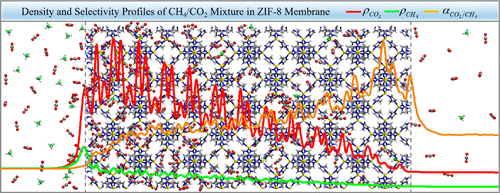当前位置:
X-MOL 学术
›
J. Chem. Inf. Model.
›
论文详情
Our official English website, www.x-mol.net, welcomes your
feedback! (Note: you will need to create a separate account there.)
Separation Selectivity of CH4/CO2 Gas Mixtures in the ZIF-8 Membrane Explored by Dynamic Monte Carlo Simulations.
Journal of Chemical Information and Modeling ( IF 5.6 ) Pub Date : 2020-03-25 , DOI: 10.1021/acs.jcim.0c00114 Zheng Wan 1 , Guobing Zhou 1, 2 , Zhongyang Dai 3, 4 , Li Li 1 , Na Hu 1 , Xiangshu Chen 1 , Zhen Yang 1
Journal of Chemical Information and Modeling ( IF 5.6 ) Pub Date : 2020-03-25 , DOI: 10.1021/acs.jcim.0c00114 Zheng Wan 1 , Guobing Zhou 1, 2 , Zhongyang Dai 3, 4 , Li Li 1 , Na Hu 1 , Xiangshu Chen 1 , Zhen Yang 1
Affiliation

|
Here we report a series of nonequilibrium dynamic Monte Carlo simulations combined with dual control volume (DCV-DMC) to explore the separation selectivity of CH4/CO2 gas mixtures in the ZIF-8 membrane with a thickness of up to about 20 nm. Meanwhile, an improved DCV-DMC approach coupled with the corresponding potential map (PM-DCV-DMC) is further developed to speed up the computational efficiency of conventional DCV-DMC simulations. Our simulation results provide the molecular-level density and selectivity profiles along the permeation direction of both CH4 and CO2 molecules in the ZIF-8 membrane, indicating that the parts near membrane surfaces at both ends play a key role in determining the separation selectivity. All densities initially show a sharp increase in the individual maximum within the first outermost unit cell at the feed side and follow a long fluctuating decrease process. Accordingly, the corresponding selectivity profiles initially display a long fluctuating increase in the individual maximum and follow a sharp decrease near the membrane surface at the permeation side. Furthermore, the effects of feed composition, temperature, and pressure on the relevant separation selectivity are also discussed in detail, where the temperature has a greater influence on the separation selectivity than the feed composition and pressure. More importantly, the predicted separation selectivities from our PM-DCV-DMC simulations are well consistent with previous experimental results.
中文翻译:

动态Monte Carlo模拟探索了ZIF-8膜中CH4 / CO2气体混合物的分离选择性。
在这里,我们报告了一系列的非平衡动态蒙特卡洛模拟与双重控制体积(DCV-DMC)相结合,以探索ZIF-8膜中CH4 / CO2气体混合物的分离选择性,厚度最高可达约20 nm。同时,进一步开发了一种改进的DCV-DMC方法以及相应的电位图(PM-DCV-DMC),以加快传统DCV-DMC模拟的计算效率。我们的模拟结果提供了沿ZIF-8膜中CH4和CO2分子渗透方向的分子水平密度和选择性分布图,表明两端膜表面附近的部分在确定分离选择性中起关键作用。在开始时,所有密度在进料侧的第一个最外层单元内的单个最大值都急剧增加,并经历了长时间的波动降低过程。因此,相应的选择性曲线最初在各个最大值处显示出长期的波动增加,并且在渗透侧的膜表面附近跟随急剧的减少。此外,还详细讨论了进料组成,温度和压力对相关分离选择性的影响,其中温度比进料组成和压力对分离选择性的影响更大。更重要的是,从我们的PM-DCV-DMC模拟中预测的分离选择性与先前的实验结果非常吻合。相应的选择性曲线最初显示出各个最大值的长期波动增加,然后在渗透侧的膜表面附近急剧减少。此外,还详细讨论了进料组成,温度和压力对相关分离选择性的影响,其中温度比进料组成和压力对分离选择性的影响更大。更重要的是,从我们的PM-DCV-DMC模拟中预测的分离选择性与先前的实验结果非常吻合。相应的选择性曲线最初显示出各个最大值的长期波动增加,然后在渗透侧的膜表面附近急剧减少。此外,还详细讨论了进料组成,温度和压力对相关分离选择性的影响,其中温度比进料组成和压力对分离选择性的影响更大。更重要的是,从我们的PM-DCV-DMC模拟中预测的分离选择性与先前的实验结果非常吻合。还详细讨论了有关分离选择性的压力和压力,其中温度对分离选择性的影响大于进料组成和压力。更重要的是,从我们的PM-DCV-DMC模拟中预测的分离选择性与先前的实验结果非常一致。还详细讨论了有关分离选择性的压力和压力,其中温度对分离选择性的影响大于进料组成和压力。更重要的是,从我们的PM-DCV-DMC模拟中预测的分离选择性与先前的实验结果非常吻合。
更新日期:2020-03-25
中文翻译:

动态Monte Carlo模拟探索了ZIF-8膜中CH4 / CO2气体混合物的分离选择性。
在这里,我们报告了一系列的非平衡动态蒙特卡洛模拟与双重控制体积(DCV-DMC)相结合,以探索ZIF-8膜中CH4 / CO2气体混合物的分离选择性,厚度最高可达约20 nm。同时,进一步开发了一种改进的DCV-DMC方法以及相应的电位图(PM-DCV-DMC),以加快传统DCV-DMC模拟的计算效率。我们的模拟结果提供了沿ZIF-8膜中CH4和CO2分子渗透方向的分子水平密度和选择性分布图,表明两端膜表面附近的部分在确定分离选择性中起关键作用。在开始时,所有密度在进料侧的第一个最外层单元内的单个最大值都急剧增加,并经历了长时间的波动降低过程。因此,相应的选择性曲线最初在各个最大值处显示出长期的波动增加,并且在渗透侧的膜表面附近跟随急剧的减少。此外,还详细讨论了进料组成,温度和压力对相关分离选择性的影响,其中温度比进料组成和压力对分离选择性的影响更大。更重要的是,从我们的PM-DCV-DMC模拟中预测的分离选择性与先前的实验结果非常吻合。相应的选择性曲线最初显示出各个最大值的长期波动增加,然后在渗透侧的膜表面附近急剧减少。此外,还详细讨论了进料组成,温度和压力对相关分离选择性的影响,其中温度比进料组成和压力对分离选择性的影响更大。更重要的是,从我们的PM-DCV-DMC模拟中预测的分离选择性与先前的实验结果非常吻合。相应的选择性曲线最初显示出各个最大值的长期波动增加,然后在渗透侧的膜表面附近急剧减少。此外,还详细讨论了进料组成,温度和压力对相关分离选择性的影响,其中温度比进料组成和压力对分离选择性的影响更大。更重要的是,从我们的PM-DCV-DMC模拟中预测的分离选择性与先前的实验结果非常吻合。还详细讨论了有关分离选择性的压力和压力,其中温度对分离选择性的影响大于进料组成和压力。更重要的是,从我们的PM-DCV-DMC模拟中预测的分离选择性与先前的实验结果非常一致。还详细讨论了有关分离选择性的压力和压力,其中温度对分离选择性的影响大于进料组成和压力。更重要的是,从我们的PM-DCV-DMC模拟中预测的分离选择性与先前的实验结果非常吻合。











































 京公网安备 11010802027423号
京公网安备 11010802027423号